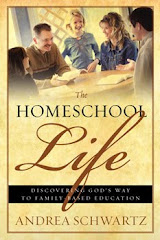This is the time of year when parents begin to make decisions about curriculum for the next school year. Although much of my curriculum is already set, I take pleasure in reading through every catalog that arrives to see what is offered and how it is presented. The offerings are much more plentiful than when I began homeschooling in 1982. The sophistication and professionalism of homeschooling materials are at an all-time high.
As I was looking through one catalogue this morning, I thought of those new to homeschooling who were wondering what to purchase and where to start. The multitude of choices can be overwhelming. My recommendation is to find a family well into their homeschooling journey, see what resources they are using, and get their feedback. Also, an internet search under "Christian homeschooling" will produce many leads to publishers who are willing to send samples of curriculum or provide online demos to watch. However, there is a step that needs to be taken alongside these activities: parents need to learn their children.
That's right, learn their children. Parents need to study and learn their child's learning style, keeping in mind his strengths and weaknesses. This is all the more reason for parents to be the ones who are actively raising their children and spending the lion's share of time with them from the outset, for it takes time to learn a child. In order to select a curriculum that will compliment strengths and improve weaknesses, the homeschooling teacher needs to select materials that accomplish two things: aid in the learning process of the student and fit the teaching style of the parent.
I don't care how many people have told me that "such and such" curriculum was the best for math. In deciding whether or not to use it, I always pictured my particular child and me sitting down at the table and proceeding through the textbook. If I didn't like the presentation or found the exercises to be tedious, I didn't choose that particular "best seller." Instead, I continued to look around and find something that would suit us. And, if that meant that we didn't have a math curriculum selected at the beginning of a school year, I didn't stress. Better to have the right curriculum than endure something that wasn't the right fit. Sometimes, I went an entirely different route, using video instruction without the use of a textbook at all.
The last thing that should prevail in a homeschool setting is an attitude of "just getting by." The priority shouldn't be with finishing the textbook on time, or rushing to meet some arbitrary deadline. When the student grasps the material, it is time to move on. Homeschooling grades should reflect real learning. As a martial arts instructor once commented, "It is better to have two sharp knives than twenty dull ones." If one student takes three years to learn something others his age learn in one, so be it. In fact, my experience tells me that many who breeze through subjects are often better at getting grades than learning the actual subject matter. (My own status of honor student while in school didn't always reflect a true understanding of the content covered.) With this mindset, I have not only been able to help sharpen my children's ability to learn, I've also gotten rid of a number of my own dull knives in the process.
Thursday, January 24, 2008
Subscribe to:
Post Comments (Atom)











No comments:
Post a Comment